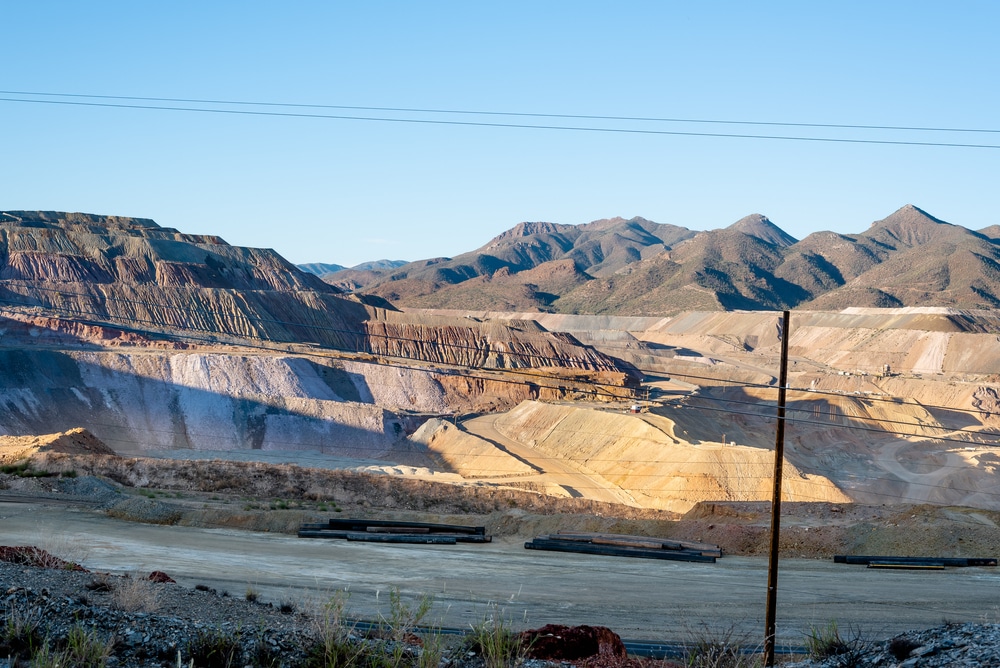The desert wind sweeps across the empty landscape where Ray, Arizona once stood, carrying whispers of a community that thrived and disappeared within a single lifetime. Today, nothing remains of this once-bustling copper town except for memories and historical records, as Ray became the rare ghost town that was not simply abandoned but completely consumed by the very industry that created it. Located in Pinal County, about 90 miles north of Tucson and 80 miles east of Phoenix, Ray represents one of Arizona’s most complete examples of the boom-and-bust cycle that defined so many Western mining communities—a town that literally sacrificed itself to the ever-expanding copper pit that was its economic lifeblood.
As you stand at the edge of the massive open-pit mine that swallowed Ray whole, you can almost hear the echoes of miners’ tools, the bustle of the town’s banks and stores, the clatter of ore trains, and the conversations that once filled the pages of the town’s newspaper. The Ray story—with its pioneer cemetery, community burial grounds, local press, and vital railroad connections—offers profound insights into how the pursuit of mineral wealth shaped Arizona’s development and the impermanence of human settlements in the face of industrial progress.

The modern-day Ray Mine, operated by ASARCO, is one of the largest open-pit copper mines in the United States. While the actual mine site is restricted to the public, you can view the massive operation from designated lookout points off the public road. It’s a striking sight, with terraced benches cutting deep into the earth and giant haul trucks visible in the distance.
Ray was once a booming mining town in the early 1900s, with thousands of residents, schools, a hospital, and a strong community. The town was dismantled in the 1950s to allow for mine expansion. Though little remains of the original structures, historical photos and accounts available in nearby museums help you imagine life during Ray’s heyday.
Just down the road are two additional ghost towns—Kelvin and Sonora—that shared mining histories with Ray. You can find old building foundations, rail lines, and interesting desert relics, making it a great spot for urban explorers and Old West enthusiasts.
Ray is part of the “Copper Corridor,” a scenic drive that passes through mining towns like Superior, Kearny, Hayden, and Winkelman. The drive includes views of mines, mountains, and desert rivers, and is a great way to immerse yourself in the region’s mining heritage.

Photographers will enjoy capturing the contrast between the massive, modern Ray Mine and the surrounding rugged desert. The terraced layers of the pit, rusty remnants of old mining equipment, and distant views of the Pinal Mountains offer dramatic backdrops for both landscape and documentary-style photography.

The Gila River runs near Ray and attracts a variety of birds and desert animals. With patience and binoculars, you may spot hawks, falcons, and even bighorn sheep in the more remote areas near the mine.

While not directly in Ray, those interested in the science and engineering of copper mining can visit ASARCO’s official Mineral Discovery Center in Sahuarita, south of Tucson. It includes educational exhibits and mine tours that explain the processes used at the Ray Mine.

The surrounding area offers opportunities for primitive camping and off-road adventures. Bring a 4WD vehicle to explore rugged desert trails, dry washes, and old mining roads. Be mindful of posted signs and restricted areas due to active mining operations.
Behind the industrial statistics and corporate decisions that shaped Ray’s history were thousands of individual lives—miners, merchants, railroad workers, teachers, and families who built a community in this remote corner of Arizona. While many of their personal stories have been lost to time, historical records provide glimpses of the human experience in this vanished town.
The dangerous nature of mining meant that tragedy was a recurring feature of life in Ray. Newspaper accounts from the Copper Camp documented accidents that claimed lives and left families struggling. One such incident in 1912 took the lives of three miners when an unexpected rock fall trapped them in a lower level of the mine. The funeral procession that followed wound through Ray’s main street, with the entire community turning out to mourn and support the widows and children left behind.
The multicultural nature of Ray’s workforce created a community that was diverse but often divided along ethnic and occupational lines. Hispanic miners, who made up a significant portion of the underground workforce, established their own neighborhood known as “Mexican Town” with its own businesses, church, and cultural institutions. These parallel communities within Ray reflected the complex social stratification common in Western mining towns while also demonstrating how different groups maintained their cultural identities.
World War I had a profound impact on Ray, with many young men departing for military service while copper production increased dramatically to support the war effort. The Copper Camp regularly published letters from local soldiers serving overseas, maintaining connections between the community and its absent members. The 1918 influenza pandemic hit Ray particularly hard, with mining operations temporarily disrupted as illness spread through the close quarters of the mines and the densely populated town.
Women’s experiences in Ray reflected both the limitations and opportunities available in early 20th-century mining communities. While primarily restricted to domestic roles, many women also operated boarding houses, worked as teachers, or ran small businesses. The relocation of the town in the 1950s presented particular challenges for Ray’s families, who had to decide whether to move to the new town of Kearny or seek opportunities elsewhere, breaking community bonds that had endured for generations.
These individual and family experiences, pieced together from newspaper accounts, company records, and oral histories, provide the human dimension to Ray’s rise and disappearance. They remind us that beyond the economic statistics and corporate decisions, ghost towns represent displaced communities and interrupted human stories.
| Category | Details |
|---|---|
| Name | Ray, Arizona |
| Type | Ghost town (former company-owned mining town) |
| County | Pinal County |
| Founded | Early 1900s (town established around 1907) |
| Status | Abandoned and demolished; replaced by expanding copper pit |
| Population (Historic) | Estimated 4,000–5,000 at its peak |
| Population (Current) | 0 (townsite destroyed for mine expansion) |
| Historical Significance | Company town for Ray Copper Mine, operated by Ray Consolidated Copper Company, later by ASARCO |
| Main Industry | Copper mining |
| Post Office | Opened in 1907; closed in 1969 |
| Decline Factors | Expansion of the open-pit copper mine; entire town was relocated or razed |
| Relocation Town | Kearny, Arizona was built in the 1950s to house displaced residents |
| Current Site Use | Occupied by the Ray Open Pit Copper Mine, operated by ASARCO (Grupo México) |
| Remnants Today | None of the original town remains; site is part of active mine property |
| Geographic Setting | Riverside area in the Dripping Spring Mountains |
| Elevation | Approx. 2,200 feet (671 meters) |
| Access | Restricted — part of a working industrial site |
| Best For | Industrial mining history research; no public tourism access |
Ray’s origins date back to the 1870s when silver prospectors first became interested in the area. In 1873, a loose organization of these early explorers began working the region, but it wasn’t until 1880 that a more substantial operation emerged with the Mineral Creek Mining Company erecting a five-stamp mill. The town was named after the Ray mine, begun by the Ray Copper Company in 1882 and reportedly named after the sister of a miner named Bullinger.
While silver initially attracted prospectors to the area, copper would ultimately define Ray’s existence. The transition from small-scale mining to industrial copper production began in earnest with corporate investment in the early 1900s. The Arizona Hercules Copper Company constructed Ray as a company town in 1909, establishing the foundation for what would become one of Arizona’s most productive copper operations.
The economic trajectory of Ray followed the classic pattern of Western mining towns, with rapid growth fueled by outside investment and industrial development. By 1914, at the height of its prosperity, Ray had grown to be the largest town in Pinal County with approximately 5,000 residents. The Ray Consolidated Copper Company emerged as the dominant mining operation, eventually becoming Arizona’s second-largest copper producer by 1917 with an annual production of 44,500 tons of copper.
Ray’s development coincided with Arizona’s transition from territory to statehood in 1912, positioning it as part of the new state’s industrial foundation. The town represented the shifting Western economy from individual prospecting toward corporate industrial mining—a transformation that would ultimately determine both Ray’s rise and its eventual demise.
Unlike most ghost towns that leave behind crumbling structures as testament to their existence, Ray presents a different kind of historical site: complete absence. The once-thriving community was entirely consumed by the expansion of the open-pit mine that gave it life, creating one of Arizona’s most unusual ghost towns—one where not even ruins remain.
The process began in the late 1940s when mining operations transitioned from underground workings to open-pit extraction. This shift in mining technique, which allowed for the processing of lower-grade ore at larger volumes, spelled the beginning of the end for the town’s physical existence. As the pit gradually expanded through the 1950s, it became clear that the town itself would eventually stand in the way of mining operations.
The solution came in the late 1950s when the Kennecott Mining Company, which had assumed control of the Ray operations in 1933, made the decision to relocate the entire community. The planned town of Kearny was specifically developed to accommodate the populations of Ray, Barcelona, and Sonora, which were about to be enveloped by the expanding copper mine. The relocation began in 1958, marking the end of Ray as an inhabited community.
Today, visitors to the area can observe the massive open-pit mine that continues operations under Asarco ownership, but nothing remains of the original townsite. The operation extracts approximately 250,000 tons of ore daily with projected reserves lasting until 2044, continuing the industrial legacy that began with Ray’s founding but erasing all physical evidence of the community that once thrived there.
The pioneer cemetery of Ray, like the town itself, no longer exists in its original form. Established shortly after the town’s founding in the early 1900s, the cemetery served as the final resting place for Ray’s earliest residents—miners who perished in accidents, victims of disease outbreaks, and families who sought their fortunes in this remote mining community.
The cemetery contained graves dating primarily from the 1909-1920 period, corresponding to Ray’s early boom years when living conditions were harsh and mining accidents common. Headstones and markers told the stories of the town’s diverse population, with inscriptions in English, Spanish, and other languages reflecting the multicultural workforce that copper mining attracted to Arizona.
Among its most notable features were the clearly delineated sections for different ethnic and religious groups—separated in death as they often were in life within the socially stratified mining community. Simple wooden crosses stood alongside more elaborate stone monuments for mine officials and prominent citizens, illustrating the economic and social hierarchy that defined Ray’s community structure.
When the decision was made to relocate Ray in the late 1950s, the cemetery faced a similar fate to the town. While details of the cemetery’s relocation are not extensively documented, records indicate that many of the graves were exhumed and transferred to cemeteries in nearby communities, including the new town of Kearny. Some families chose to relocate their deceased loved ones to their new communities outside the area, while others accepted reburial in designated sections of regional cemeteries.
The process of relocating a community’s cemetery—with all the emotional, cultural, and logistical challenges it presented—adds another layer to Ray’s unusual story, highlighting the profound disruption that industrial expansion caused not just for the living community but also for its historical continuity and connection to its departed members.
As Ray developed from a mining camp into a substantial town, a more formal community cemetery was established to serve its growing population. This larger burial ground, located on the outskirts of the original town, reflected Ray’s increasing social complexity and demographic diversity during its peak years between 1910 and the 1940s.
The community cemetery served a broader cross-section of Ray’s population, including workers from various levels of the mining operation, merchants, professionals, and their families. Unlike the pioneer cemetery with its rudimentary markers, the community cemetery featured more elaborate monuments and family plots, reflecting the increasing prosperity and permanence that residents felt during Ray’s heyday.
Cultural divisions remained visible in the cemetery’s organization, with sections that reflected the town’s ethnic diversity—including areas for Hispanic, European immigrant, and Asian American residents. These divisions mirrored the workforce stratification common in Western mining communities while also preserving distinct cultural traditions around burial and remembrance.
By the 1940s, the cemetery contained several decades of Ray’s history, with grave markers chronicling the town’s evolution, mining disasters, disease outbreaks, and gradual stabilization. Family plots told stories of generational commitment to the community, while military markers honored those who had served in World War I and World War II before returning to Ray.
When the mine expansion threatened the town in the 1950s, the community cemetery, like the pioneer cemetery, required relocation. The process involved careful documentation, family notifications, and the physical transfer of remains to new locations—primarily in Kearny or other communities where families had relocated. This disruption of sacred ground represented yet another sacrifice the community made to the continuing operations of the mine, emphasizing how completely industrial priorities could reshape not just current communities but also their historical connections and final resting places.
The primary newspaper serving Ray during its most prosperous period was the Arizona Copper Camp, established in February 1910 by Walter Lyon and Frank Lovett. This weekly publication chronicled Ray’s development during a crucial decade of growth and prosperity, operating until December 25, 1920, when it printed its final edition.
The Copper Camp functioned as both a news source and a booster for Ray and the broader mining industry. Its pages documented mining developments, town events, social gatherings, and business opportunities, creating a vivid record of daily life in an early 20th-century Arizona mining community. The paper proudly promoted Ray’s virtues, with one article entitled “Whoop ‘er Up For Ray” declaring it “the best mining camp in the state of Arizona to live in.”
Originally independent, by 1915 the newspaper was published by the Ray Publishing Company. The editorial direction was maintained through a series of “Local Representatives,” beginning with T.S. Jacobs, who had previously worked for Ray Consolidated Copper Company—a connection that likely influenced the paper’s generally pro-industry stance. Over the next five years, five different men served in this role, with Jacobs returning in late 1919 and remaining until the paper ceased publication.
The Copper Camp’s offices occupied a prominent location on Ray’s main street, serving as both a business and a community gathering point where residents could share news and information. The printing press itself was considered a sign of the town’s modernity and permanence, a technological investment that signaled Ray’s transition from temporary camp to established community.
The newspaper’s decade of publication coincided with Ray’s peak years and ended as the post-World War I copper market began to soften. Its final editions documented the beginning of the economic contraction that would eventually lead to the town’s transformation. Today, the complete run of the Arizona Copper Camp is preserved in the Library of Congress’s Chronicling America digital collection, providing researchers and historians with an invaluable window into Ray’s brief but significant existence.
The railroad proved essential to Ray’s development, transforming what might have remained a small mining outpost into a substantial industrial community. The Ray and Gila Valley Railroad, built in 1909-1910 as a subsidiary of Ray Consolidated Copper Company, connected the town to the wider transportation network that was crucial for moving both people and materials.
This standard gauge railroad linked Ray to Ray Junction, eight miles away, which provided access to the Arizona Eastern Railroad. This connection was vital for transporting ore from the mines to the mill located 18 miles away at the junction of the Gila and San Pedro rivers. Without this transportation link, Ray’s industrial-scale copper production would have been impossible, as the economics of copper mining depend on the efficient movement of large volumes of relatively low-value ore.
The railroad infrastructure included a substantial depot in Ray, serving both passenger and freight operations. Daily passenger service connected Ray to regional centers, making the town less isolated than many mining communities and allowing residents to maintain connections to larger population centers. For freight, the railroad carried not just outgoing ore but also incoming supplies, equipment, construction materials, and consumer goods that supported Ray’s growing population.
The rail yards became a social hub for the community, with arrivals and departures marking the rhythm of town life. Mail, newspapers, and visitors all came by train, making the depot a communication center as well as a transportation facility. Railroad employees formed an important segment of Ray’s workforce, adding occupational diversity beyond mining and creating another layer in the town’s social structure.
As mining operations shifted from underground to open-pit extraction in the late 1940s, the relationship between the railroad and the mine changed as well. New transportation technologies, including increasingly large haul trucks, began to replace railroads for moving ore within the mining complex. By the time Ray was relocated in the late 1950s, the traditional railroad’s role had diminished, though the broader rail network remained important for shipping processed copper to market.
The Copper Basin Railway eventually replaced the earlier rail lines, maintaining the region’s connection to the national rail network even as the original town of Ray disappeared beneath the expanding mine. This evolution of transportation infrastructure illustrates how technological change drove both economic development and community transformation in Arizona’s mining districts.
Ray’s decline followed a different pattern from most ghost towns, as it wasn’t simply abandoned due to depleted resources but rather sacrificed to access the very resources that had sustained it. The transition began gradually after World War I when copper prices softened and mining operations contracted. The post-war economic readjustment affected many Arizona mining communities, though Ray maintained significant operations through the 1920s.
The Great Depression hit copper mining particularly hard, with prices falling dramatically and production scaling back. The Kennecott Copper Corporation assumed control of Ray’s mining operations in 1933 during this challenging period, implementing new management practices and technologies to maintain profitability despite difficult market conditions.
While World War II temporarily boosted demand for copper and revitalized operations, the post-war period brought the most significant transformation to Ray. In the late 1940s, mining methods shifted from underground operations to open-pit extraction. This technological change allowed for the processing of lower-grade ore bodies at higher volumes, fundamentally altering the relationship between the mine and the town.
By 1955, the conversion to open-pit mining was complete, and the expanding pit began to threaten the town’s physical existence. The decision to relocate the community came when geological surveys revealed that the richest remaining copper deposits lay directly beneath Ray itself. Rather than simply close the mine, Kennecott chose to move the town, establishing Kearny in 1958 as a planned community to accommodate the populations of Ray, Barcelona, and Sonora.
The relocation process itself caused significant community disruption. Some residents embraced the move to a new, modern community, while others resisted leaving the only home they had known. Property owners negotiated compensation, while renters often faced more precarious circumstances. Schools, churches, and businesses had to decide whether to reestablish in Kearny or dissolve entirely.
By the late 1950s, Ray as a living community ceased to exist, with its population relocated and its physical structures either moved, demolished, or eventually consumed by the expanding mine. The town’s disappearance was complete by the 1960s, marking one of the most thorough erasures of a significant Arizona community in the state’s history.
Ray occupies a distinctive place in Arizona’s mining history as a community that was not merely abandoned but deliberately relocated and then physically erased to accommodate industrial expansion. This unusual fate makes it particularly valuable for understanding the relationship between resource extraction, corporate decision-making, and community continuity in the American West.
The town’s relatively brief existence—from its formal establishment in 1909 to its relocation beginning in 1958—coincided with critical transitions in Arizona history. Ray witnessed the territory’s achievement of statehood, the economic booms associated with both World Wars, the hardships of the Great Depression, and the post-war industrial expansion. This timeline makes Ray a microcosm for studying how these broader historical currents affected local communities.
For archaeologists and historians, Ray presents unique challenges and opportunities. Unlike most ghost towns that leave physical remains for study, Ray’s complete erasure means that research must rely more heavily on documentary sources, oral histories, and comparative analysis with similar mining communities. The Arizona Historical Society maintains significant archival materials related to Ray, including photographs, business records, and personal accounts that help reconstruct this vanished community.
The planned town of Kearny, created specifically to replace Ray, represents an important case study in mid-20th century community planning and corporate paternalism. Its layout, architecture, and amenities reflected contemporary ideas about ideal community design while also serving the practical needs of the mining operation that necessitated its creation.
Ray’s newspaper, the Arizona Copper Camp, has been digitized and preserved through the Library of Congress’s Chronicling America project, making it accessible to researchers worldwide. These weekly issues from 1910-1920 provide invaluable insights into daily life, business developments, social activities, and community concerns during Ray’s peak period, ensuring that even though the physical town has disappeared, its stories remain accessible.
For the broader study of Western mining history, Ray exemplifies the full life cycle of resource extraction communities—from initial discovery through industrial development to eventual depletion and transformation. The town’s complete subordination to industrial priorities raises important questions about community sustainability, corporate responsibility, and the true costs of resource extraction that remain relevant in contemporary discussions of mining communities worldwide.
The relocation of Ray’s cemeteries in the 1950s presented unique challenges for preserving the community’s memorial traditions. Unlike abandoned ghost town cemeteries that simply fall into disrepair, Ray’s burial grounds underwent an organized disinterment and reburial process that transformed how successive generations would connect with their ancestors.
When the decision was made to relocate the community, families faced difficult choices regarding their deceased loved ones. Many opted to have remains transferred to the new cemetery established in Kearny, creating a physical connection between the new community and its predecessor. Others chose to relocate burials to their new communities elsewhere in Arizona or beyond, dispersing Ray’s memorial heritage across multiple locations.
The Kearny cemetery contains a dedicated section for reinterred Ray burials, with many of the original headstones and markers preserved. This area serves as perhaps the most tangible remaining connection to the original town, a place where former residents and their descendants can maintain memorial traditions despite the complete erasure of Ray itself.
Documentation of the original cemeteries before relocation was unfortunately incomplete by modern standards. While basic records were maintained of which graves were moved and where, much of the contextual information about the original cemetery layouts, individual grave locations, and smaller unmarked burials was lost in the transition. This documentation gap presents challenges for genealogists and historians attempting to reconstruct Ray’s community structure and family histories.
Memorial practices have evolved to accommodate the unusual circumstances of Ray’s disappearance. Annual reunions of former Ray residents and their descendants sometimes include cemetery visits and commemorative activities. These gatherings serve to maintain community connections that transcend geographic displacement, allowing for the sharing of memories and stories about life in the vanished town.
In recent decades, local historical societies have worked to improve documentation of the relocated graves, creating more comprehensive records that connect current burial locations with original Ray cemetery placements. These efforts help preserve the memorial continuity disrupted by the town’s relocation and ensure that future generations can trace their connections to this vanished community.
Unlike most ghost towns that offer physical sites for visitors to explore, Ray presents a different kind of historical tourism challenge. Since the original townsite has been completely consumed by mining operations, there are no ruins or structures to visit, and the active mine site remains closed to public access for safety and security reasons.
Those interested in Ray’s history can instead explore several alternative connections to this vanished community. The town of Kearny, located approximately 15 miles southeast of the original Ray site, serves as the most direct legacy of the former mining community. Some buildings from Ray were physically relocated to Kearny during the transition, and the town’s museum contains artifacts, photographs, and documents related to Ray’s history.
The Kearny cemetery, with its section dedicated to reinterred Ray burials, offers perhaps the most tangible connection to the original community. Visitors should approach this area with appropriate respect, recognizing that these graves represent not just historical artifacts but the final resting places of individuals whose communities were disrupted even after death.
Several museums in the region maintain exhibits related to Ray and other Arizona mining communities. The Arizona Historical Society in Tucson houses significant collections of photographs, documents, and artifacts from Ray, providing researchers and casual visitors alike with insights into the town’s development and ultimate fate. The Copper Corridor Economic Development Coalition also maintains information about the region’s mining heritage, including Ray’s significance.
Digital resources offer another avenue for exploring Ray’s history. The Library of Congress’s Chronicling America collection includes digitized issues of the Arizona Copper Camp from 1910-1920, allowing virtual visitors to read the town’s news exactly as residents did a century ago. These newspapers provide vivid glimpses into daily life, business developments, and community events during Ray’s peak years.
For those who wish to view the physical location where Ray once stood, there are limited public viewpoints from which the massive open-pit mine can be observed from a safe distance. These perspectives help visitors grasp the scale of the industrial operations that first created and ultimately consumed the community.
As the sun sets over the massive excavation that once was Ray, casting long shadows across the altered landscape, we are reminded of the profound impermanence of even our most substantial human endeavors. Ray’s story—from silver discovery to copper boom to complete erasure—offers a particularly stark illustration of how thoroughly industrial priorities can reshape not just the natural environment but entire human communities.
What distinguishes Ray from countless other Western ghost towns is the completeness of its transformation. Where most abandoned mining communities leave at least ruins for future generations to explore, Ray vanished so thoroughly that nothing remains to mark its existence except for photographs, documents, and the memories of those who once called it home. This absolute erasure makes Ray both more challenging to study and more compelling as a case study in community displacement.
The planned relocation to Kearny adds another dimension to Ray’s historical significance, representing a rare case where a company took responsibility for creating an alternative community rather than simply abandoning workers when resources were depleted. This transition, while disruptive, offered continuity that most ghost town residents never experienced, allowing community bonds to partially survive the physical town’s disappearance.
Ray’s newspapers, cemetery relocations, and railroad connections each illuminate different aspects of how communities establish themselves in challenging environments and how their physical and social infrastructures respond to economic pressures. These elements, studied together, provide insights into the complex relationship between resource extraction industries and the communities that serve them.
As contemporary mining operations continue to reshape landscapes across the American West and globally, Ray’s experience offers valuable perspectives on balancing resource development with community sustainability. The questions raised by Ray’s fate—about corporate responsibility, environmental transformation, community rights, and historical preservation—remain relevant in current discussions of mining communities worldwide.
In the end, perhaps Ray’s most enduring legacy lies not in any physical monument but in the stories, traditions, and community bonds that survived its disappearance. Former residents and their descendants maintain connections through reunions, shared memories, and historical preservation efforts, demonstrating that while towns may vanish, the human communities they once housed find ways to persist across time and space.